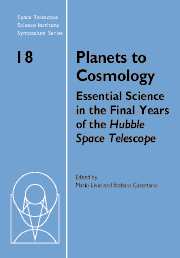 Planets to Cosmology
Planets to Cosmology Book contents
- Frontmatter
- Contents
- Participants
- Preface
- Hubble's view of transiting planets
- Unsolved problems in star formation
- Star formation in clusters
- HST abundance studies of low metallicity stars
- Physical conditions and feedback: HST studies of intense star-forming environments
- Quasar hosts: Growing up with monstrous middles
- Reverberation mapping of active galactic nuclei
- Feedback at high redshift
- The baryon content of the local intergalactic medium
- Hot baryons in supercluster filaments
- Galaxy assembly
- Probing the reionization history of the Universe
- Studying distant infrared-luminous galaxies with Spitzer and Hubble
- Galaxies at z ≈ 6–i′-drop selection and the GLARE Project
- The Hubble Ultra Deep Field with NICMOS
Hubble's view of transiting planets
Published online by Cambridge University Press: 17 August 2009
- Frontmatter
- Contents
- Participants
- Preface
- Hubble's view of transiting planets
- Unsolved problems in star formation
- Star formation in clusters
- HST abundance studies of low metallicity stars
- Physical conditions and feedback: HST studies of intense star-forming environments
- Quasar hosts: Growing up with monstrous middles
- Reverberation mapping of active galactic nuclei
- Feedback at high redshift
- The baryon content of the local intergalactic medium
- Hot baryons in supercluster filaments
- Galaxy assembly
- Probing the reionization history of the Universe
- Studying distant infrared-luminous galaxies with Spitzer and Hubble
- Galaxies at z ≈ 6–i′-drop selection and the GLARE Project
- The Hubble Ultra Deep Field with NICMOS
Summary
The Hubble Space Telescope is uniquely able to study planets that are observed to transit their parent stars. The extremely stable platform afforded by an orbiting spacecraft, free from the contaminating effects of the Earth's atmosphere, enables HST to conduct ultra-high precision photometry and spectroscopy of known transiting extrasolar planet systems. Among HST's list of successful observations of the first such system, HD 209458, are (1) the first detection of the atmosphere of an extrasolar planet, (2) the determination that gas is escaping from the planet, and (3) a search for Earth-sized satellites and circumplanetary rings. Numerous widefield, ground-based transit surveys are poised to uncover a gaggle of new worlds for which HST may undertake similar studies, such as the newly-discovered planet TrES-1. With regard to the future of Hubble, it must be noted that it is the only observatory in existence capable of confirming transits of Earth-like planets that may be detected by NASA's Kepler mission. Kepler could reveal Earth-like transits by the year 2010, but without a servicing mission it is very unlikely that HST would still be in operation.
Introduction
When both the photometric transits and the radial velocity variations due to an extrasolar planet are observed, we are granted access to key quantities of the object that Doppler monitoring alone cannot provide. In particular, precise measurements of the planetary mass and radius allow us to calculate the average density and infer a composition.
- Type
- Chapter
- Information
- Planets to CosmologyEssential Science in the Final Years of the Hubble Space Telescope: Proceedings of the Space Telescope Science Institute Symposium, Held in Baltimore, Maryland May 3–6, 2004, pp. 1 - 12Publisher: Cambridge University PressPrint publication year: 2006
- 1
- Cited by


